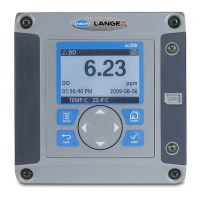50
General pH Information
electrode/meter, time required to deliver the reagent to the process water, time required
for the reagent to mix with and react with the process water, and the time required to
deliver the completely mixed water to the electrode. If the delay times are too long or the
mixing is not complete, the control will be poor regardless of how well the controller is
tuned.
The Process pH Meter uses a PID (proportional, integral (reset), derivative (rate) control)
control algorithm. Each of the instrument settings along with their effects on the control
loop, are described below.
Mode
Manual: The manual output is specified in percent of full-scale PID output
(4–20 mA) and is commonly used for testing the output device.
Auto: Allows the process to be controlled automatically using information specified in the
Phase, Setpoint, Proportional Band, Integral, and Derivative menus as follows:
Phase
Direct: The control output action will cause the process value to increase.
Reverse: The control output action will cause the process value to decrease.
Setpoint
The setpoint is defined as the desired process value in pH
Proportional Band
The proportional band is the range in pH from the setpoint value where the controller
provides proportional control. For example, the desired setpoint for the process is pH 7.0
and the process requires that a reagent must be added to the process water to bring it up
to pH 7.0. If the proportional band is set to pH 1.0, the controller will provide proportional
output control over the range of pH 6.0 to 8.0. When the process is at pH 6.0, the
controller will provide a 100% control output level (assuming that Phase is set to Direct).
When the process is at pH 7.0, the proportional control will provide a 0% control output
level. When the process is at pH 6.5 the proportional control will provide a 50% output.
The output action is equal to the difference between the setpoint and the process value,
divided by the proportional band value.
Integral
The integral value is used to reduce the steady state error, between the process value and
the setpoint, to zero. For example, assume a process can be manually controlled at a level
of pH 8.0 by sending a 35% control output level to a reagent pump. Now, say that the
system is set up for the controller to provide proportional only control, with the controller
setpoint set to pH 8.0 and the proportional band set to pH 1.0. Note that the nearer the
process gets to the pH 8.0 setpoint, the lower the control output level is. In fact, when the
process is at pH 8.0, the output level will be 0%. Since the process requires that the pump
be operated at 35% for the process to reach pH 8.0, its apparent that proportional-only
control will never quite reach the desired setpoint of pH 8.0. This is where the integral
control comes in.
Integral control can be thought of as adding up the output acti
on from the proportional
control over time. For example, the proportional control output reaches a steady state
level of 5%. If the integral time is set to five minutes, the integral action of the controller will
add an additional 5% to the controller output level over a 5-minute interval. The integral
action is additive, so for every 5-minute interval an additional 5% is added to the
controller's output level. This will allow the controller to bring the process to the desired
setpoint level. Note that the longer the integral time setting, the longer it takes for the

